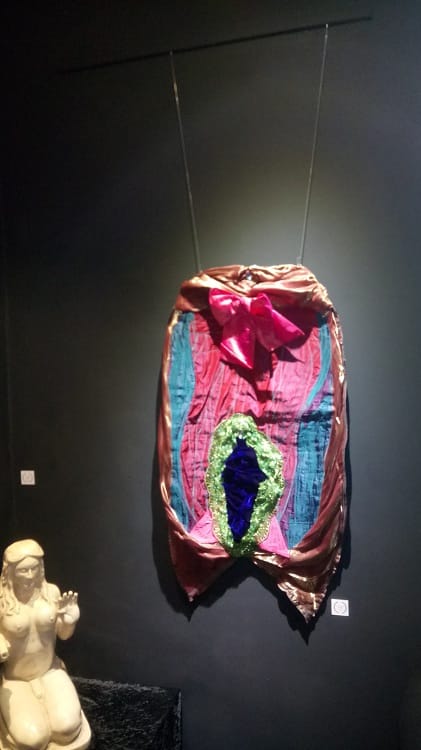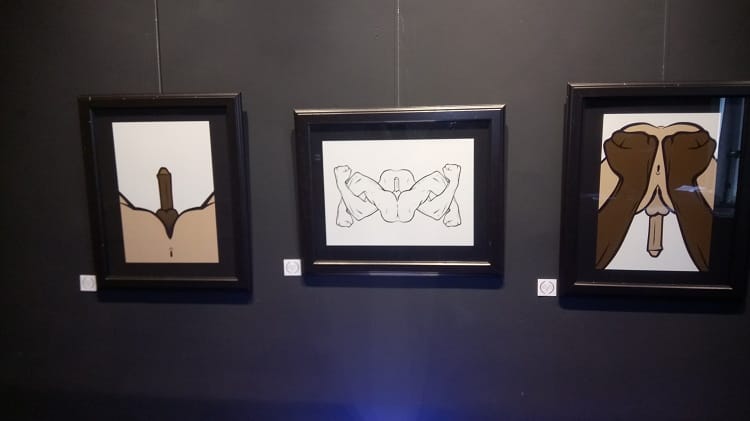Did the council follow the correct process to name Herzog Park back in 1995?
Or has Rathgar been living with Orwell Quarry Park all this time?
The Cock and Pussy Manifesto, which includes equal numbers of artworks devoted to female genitalia and male genitalia, runs until 23 September at Gallery X.

Artist and gay-rights activist Will St. Leger had been working on a trio of images for over a year.
They tackled assumptions about power and submission in gay relationships, as well as the pressure on gay men to conform to conventional standards of beauty.
But the artwork was so graphic that St. Leger wasn’t sure if he would be able to find a venue to display it. Then one day on the street he bumped into the curator of Gallery X, Giovanni Giusti.
“’You are going to love our next exhibition, it’s a cock-and-pussy exhibition,’” he recalls Giusti saying to him. “I grabbed his arm and said, ‘Oh my god, I’ve got a piece of work for that!’”
That exhibition, called The Cock and Pussy Manifesto, opened on 31 August and runs through 23 September at the gallery on South William Street.
It includes roughly equal numbers of works by several artists on the subject of female genitalia and male genitalia (including St Leger’s work).
Giusti says the show is meant as an attack on the shame that society makes us feel about what he believes are our most important bits. “Society bans the key elements of pleasure, suffocating them in a cloak of shame,” he says.
Shame and covering up our genitals predates Christianity and is a factor in most cultures and societies around the world, says Giusti. “It is almost a prerequisite of civilisation,” he says.
Once their sexuality is repressed, people turn to other goals, such as collecting material possessions, which means that they are easier to control, says Giusti. So shame serves a purpose for powerful elites, he says.
“Once we are shamed, our energy and desire are ready to be redirected towards substitute goals, through which we can be manipulated.”
We are also more open to being manipulated to engage in mob violence if we are sexually frustrated, he suggests.

An artwork called Fanny, by artist Joanne Callaghan, is a large, colourful interpretation of female genitalia made of velvet and satin in bright pink, blue, and green.
Callaghan says that a lot of the material she uses is recycled. “I love texture and I love things you can touch,” she says.
She is excited about the exhibition, as it’s her first, and the first time her work has focused on genitals.
“A woman’s womb is the core of herself. Everything happens there – from intuition, childbirth, death of a child if still-born.” she says. “Lust, love, instinct … It [the womb] does influence everything that goes on in a woman’s life.”
Callaghan wanted the piece to represent the connection between the vagina and the womb, she says.
“People are attracted to it, like a vortex, you end up plunging into it,” says Giusti. “It’s sufficiently non-graphic that you could actually put it in your house.”
In St. Leger’s trio of pieces, called Sex and Power, the main picture portrays an erect penis and a backside, wrapped in very muscular arms.
The picture can be turned around so the one who was on top is then on the bottom.
St. Leger says this challenges the assumptions often made about sex, and about gay male sex in particular, that one partner is dominant and the other submissive.
“The binary idea that the person on top is powerful and the person on the bottom is submissive – it doesn’t reflect the real-world sexual experience,” he says.

The ultra-muscly arms portray his concern that there is a “clone army” growing, where everyone has to look a certain way in order to be considered attractive.
Body dysmorphia and anorexia are growing among men, St. Leger says, and gay men are going to extreme lengths to conform to the stereotypical ideals of what looks good.
It’s “the narcissistic idea of this gym-fit gay guy – no pecs, no sex. That is what I’m rallying against,” he says. “The reductive quality of how we, particularly gay men, view each other.”
Another picture in St. Leger’s trio of works portrays white legs with a black penis. This is a commentary on the stereotyping of black men that can take place, he says.
“The stereotyped ideas that go with race, that black men are being reduced down to having a big member, I wanted to challenge those things as well,” he says.
In addition to Callaghan’s and St. Leger’s artworks, there are two pieces in the exhibition that represent the Sheela na Gig, an ancient carving of a female figure showing an exaggerated vulva.
Giusti would have loved to get his hands on an original. “I tried to have a real Sheela na Gig, but the ones in Ireland are all owned by the state,” he says.
Giusti says we need another sexual revolution to bring about a truly equal society.
“In the ’70s the sexual revolution was only really for men … [but] it only really works if everyone is participating and everyone is free to do what they want,” Giusti says.
You may be forgiven for thinking you are already living in a highly sexualised society, especially with the influence of pornography on popular culture, but Giusti’s vision is very different.
He wants women to be liberated, not objectified, he says. “Being an object is one thing. If you are the subject of desire that is a different thing,” he says.
So, what does a sexual revolution mean? Giusti believes people would be much happier if they were free of shame and could experience sexual pleasure more easily.
We should celebrate our genitals as our most important body parts, he says. “They are the core and the source of all our desire, the part of our body that is the only real reason for the existence of all the other parts,” he says in his manifesto, which is also part of the exhibit.
Giusti wants to bring this celebration of genitals out of the gallery and into the streets. “I would love it if there were no laws that say you can’t go around naked,” he says. “Why do we have to hide?”
The Cock and Pussy Manifesto runs in Gallery X on South William Street until 23 September.